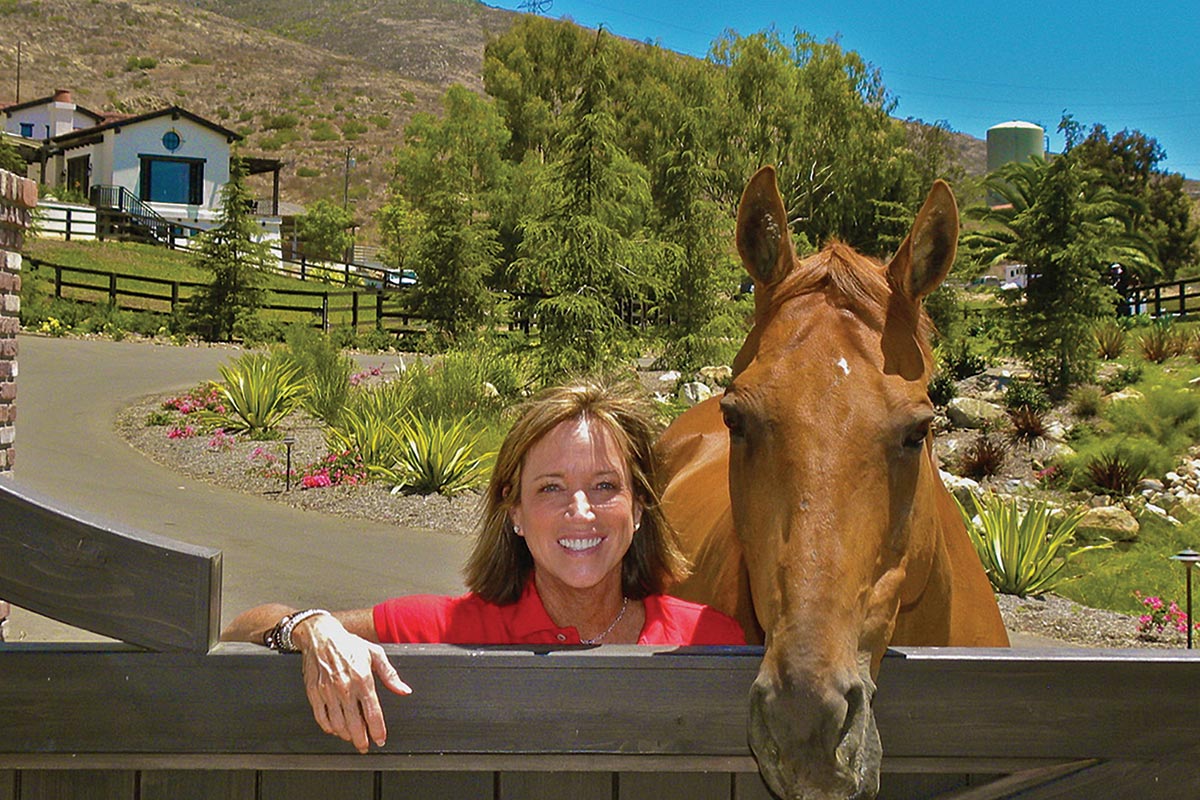This article about a positive reinforcement trainer appeared in the June 2021 issue of Horse Illustrated magazine. Click here to subscribe!
[ad_1]
What do hyenas, meerkats, hippos, rhinos, lions, tigers, bears, giraffes, llamas, zebras, goldfish, orcas, sea lions, Beluga whales, walruses, and dolphins have in common with horses? They can all be trained using positive reinforcement techniques. And nobody knows this better than positive reinforcement trainer and animal behaviorist Shawna Karrasch.
Many people know positive reinforcement training by the terms “clicker training” or “R+.” Although Karrasch didn’t create the techniques, there’s no doubt that she has been a pioneer in bringing them to the horse world.
From 10,000 to 1,200 Pounds
Karrasch first developed skills as a positive reinforcement trainer when she worked as a marine mammal trainer at Sea World in San Diego, Calif., for a decade. There, she worked with sea lions, walruses, otters, Beluga whales, killer whales, and different types of dolphins.

Her life changed dramatically in 1992 when she attended a show jumping grand prix. By the end of the night, she was enthralled.
“I didn’t even know what posting a trot was, and I wanted to be a grand prix show jumper in my 30s,” she laughs. “At that point, I had been flying off the nose of whales, so a big fence on a horse didn’t seem like anything. In fact, horses were kind of cute and little. They’re not 10,000 pounds. They’re 1,200.”
She knew she could put her accumulated knowledge of positive reinforcement training with the whales to work with horses, but first she had to learn the ropes of the horse industry. She began taking beginner riding lessons and even riding on calls with veterinarians and farriers to learn everything she could.
“I was that 12-year-old girl,” she admits. “I’d be talking about horses, horses, horses. Within a couple months, I ended up buying my own horse, and then I was showing, and I really, really loved it.”
Positive Reinforcement Basics
She kept asking horse people if they used positive reinforcement during training but was told “no” over and over. However, her experiences on the executive board of the International Marine Animal Trainers Association had shown her that all sorts of zoo and marine animals could be trained with positive reinforcement. A phone conversation with legendary trainer Tom Dorrance gave her the green light that her methods of animal training should work on horses.
Because all she had done with the marine mammals was positive reinforcement, she had a hard time grasping the concept of pressure and release, also known as negative reinforcement, which is much more common in the horse industry.
“I try to remind people, positive and negative don’t mean good and bad; they mean plus and minus,” she explains. “So when people talk about negative reinforcement, it doesn’t mean you beat your horse. It means you apply pressure and take the pressure away, and that subtraction of the pressure is what increases the frequency of the behavior. On the other side, adding something to the equation, like food, increases a behavior. So we have two different ways that we can reinforce them.”
An Opportunity for Positive Reinforcement with Horses
Her big break came alongside her then-husband, Vinton Karrasch. The couple were invited by Vinton’s friends, John and Beezie Madden, to move to New York so they could use positive reinforcement methods with the Maddens’ show jumpers. She called this her “lab time” as she began to finesse her techniques.
Her success with the Maddens’ horses began to turn heads, and the first clinic she ever booked was for people attending the Festival of Champions at the USET hedquarters. After more than a year at the Maddens, she left to start her business, On Target Training.
Karrasch assumed that the horse world would wholly embrace it, but that wasn’t the case. Especially since it was something new coming from a newcomer. However, the fact that she had trained orcas and other marine mammals gave her credibility. At first, some people came just to see the “whale lady.”

One of the biggest challenges to working with clients back then was that there wasn’t enough material for riders to follow through on, and many would go back to training the way they had always known.
“I was one person who couldn’t really be there to help them to follow through,” she says. “My book wasn’t even written yet. Now with the internet, we have so many more resources for people.”
The Future as a Positive Reinforcement Trainer
Her first book was You Can Train Your Horse to Do Anything! On Target Training Clicker Training and Beyond, released in 2000. Her second book, published by Trafalgar Square Books, called The Power of Positive Horse Training: Creating Exceptional Behavior by Changing Equine Relationships with the World Around Them, dropped in November 2021.
In 2020, she partnered with Via Nova Training, a dressage and eventing facility in Santa Fe, N.M., and became their lead behaviorist and trainer. She is teaching the entire team at Via Nova how to use and teach positive reinforcement training.
Her goal is to keep everyone learning and growing with the techniques. To do so, she’s embraced technology to teach others via video, webinars, a blog, social media, and a podcast, Equine Clicker 101 with Shawna Karrasch.
Karrasch points out that positive reinforcement is of great benefit to the horse because horses are always communicating. Sometimes it’s subtle, but people can learn to read cues and emotional state.
She emphasizes that positive reinforcement training should be fun for you and your horse.
“If the marine mammals didn’t think the training was fun, they wouldn’t show up,” she says. “It’s the same with the horses.”
[ad_2]
Source link
